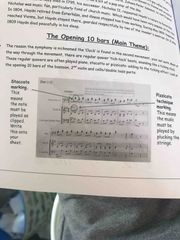![]()
![]()
![]()
Use LEFT and RIGHT arrow keys to navigate between flashcards;
Use UP and DOWN arrow keys to flip the card;
H to show hint;
A reads text to speech;
27 Cards in this Set
- Front
- Back
|
Why is it known as the clocks symphony |
as there a regular tick tock beats sounding like a ticking clock |
|
|
how are the notes played to get the sound of a tick tock |

They are played as a regular quavers to add a ticking effect (staccato - played as clipped and pizzicato - plucked) |
|
|
What’s another rhythmic feature found regularly throughout the peice |
dotted rhythms An ordinary dotted rhythm which adds an extra half length to the night A double ducted note which adds half and then a quarter |
|
|
what is the main melodic theme |

Back (Definition) |
|
|
Symphony structure
|
|
|
|
what key is the beginning section (bars 1 to 35) in |
A major key because there is an F sharp used throughout this means it’s in G major for section a |
|
|
from bars 36 to 64 (section B) there is a key change what is it |
Goes from G major to G minor as there are two flats played instead of one sharp |
|
|
For section 2A there is another key change what is it and how long does it last for |
it goes back to G major and lasts for 88 bars |
|
|
why is section a2 known as a2 not a |
as it’s not exactly the same so we can’t label it as section a |
|
|
What is the word for the structure of this piece |
Ternary form |
|
|
What is ternary form |
when the piece is split into three sections (ABA) where a and the second a are exactly the same or very similar |
|
|
What is an antecent phrase |
First phrase in a period |
|
|
How does the end bar nine finish |
it’s a perfect cadence (chord V) |
|
|
In what bar does the dotted rhythms come back again |
The opening of bar 10 on the first violins |
|
|
When does the first double dotted rhythm come in And then how many bars is it played for |
in bar 17 and is played on the first note of the bar the bar is 17 1819 and 20 |
|
|
what does Haydn do in bars 16-23 and 29 |
he uses a chromatic scale sometimes doesn’t use the whole scale |
|
|
What happens in bar 23 |
Demonstrates a typically classical way of using articulation-a combination of slurred and staccato notes |
|
|
how long is section b |
29 bars long |
|
|
how long is section b |
29 bars long |
|
|
in what bar do all instruments play |
bar 36 |
|
|
how is the key change in section 2 shown |
as the cellos and basses play a defending g minor scale |
|
|
What happens after 10 bars of articulation |
The texture thins |
|
|
Bar 58 onwards what do the cellos and bases do |
They pay repeated D’s - this is called a pedal point. this builds tension and prepares the listener for the return of the opening key (G major) |
|
|
what idea does section a to create |
Creates the idea of coming home and returns to the original music content |
|
|
what happens at the start of section a2 |
at the start of section A 2 the music returns to the regular tick tock to beat |
|
|
how does haydn thin out the texture from bar65 to create variety |
only one flute please it is Marked P and staccato only one bassoon plays and is also marked P and staccato only one oboe plays a few notes (bars 68-69 and bars 77-78) |
|
|
what is the key change in bar 100 and how does Hayden achieve the smooth transition |
The key change is to b flat major and he achieves the smooth transition by playing the new G in bar 98 |

